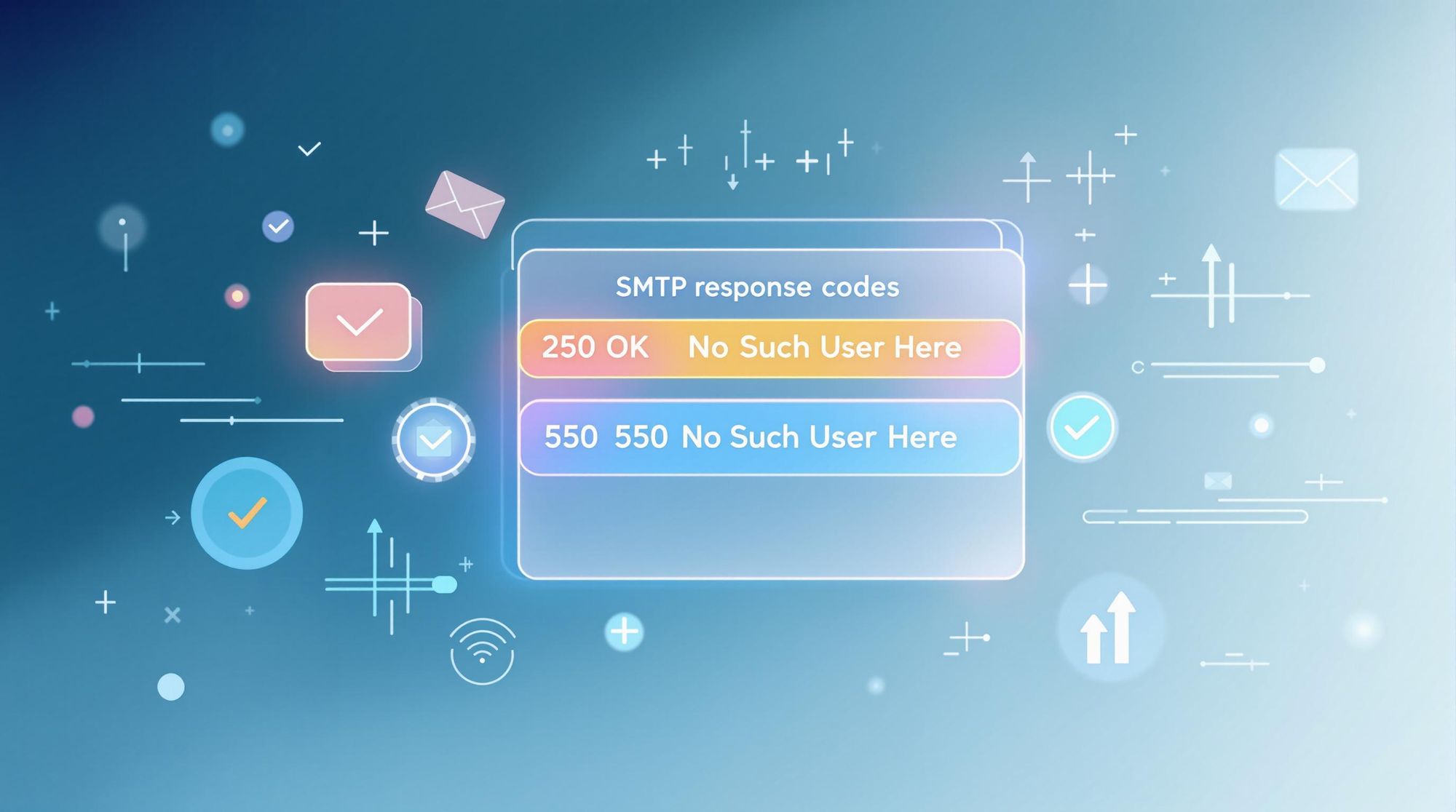SMTP response codes are the backbone of email validation. These three-digit codes tell you whether an email was successfully delivered, temporarily delayed, or permanently failed. Understanding these codes helps you maintain clean email lists, reduce bounce rates, and protect your sender reputation.
Here’s a quick breakdown:
- 2xx (Success): Email processed successfully (e.g.,
250 OK). - 4xx (Temporary Errors): Issues like server overload or mailbox full. Retry later (e.g.,
421 Server Unavailable). - 5xx (Permanent Errors): Invalid addresses or delivery failures. Remove these from your list (e.g.,
550 Invalid Address).
For effective email validation:
- Remove addresses flagged by permanent errors.
- Retry sending emails with temporary errors using backoff strategies.
- Use tools like Bounceless.io to automate validation and improve deliverability.
Why it matters: Around 30% of email addresses become outdated yearly. Regularly validating emails using SMTP codes ensures higher deliverability and a strong sender reputation.
How to understand the SMTP Server Response Codes
SMTP Response Code Types
SMTP response codes are grouped into three main categories, each playing a role in email validation.
2xx Success Codes
These codes indicate that the email has been processed successfully. For instance, Code 252 confirms the address but postpones complete verification [4].
4xx Temporary Error Codes
These codes point to temporary problems that might resolve on their own. Common ones include:
- 421: Server unavailable
- 450: Mailbox full
- 451: Processing error
These issues require retry attempts to ensure delivery. Following proper retry protocols can prevent server overload and boost delivery success. Many temporary problems are resolved within 1-2 days [3].
5xx Permanent Error Codes
The 5xx codes signal permanent problems that need immediate action. Examples include:
- 550: Invalid Address
- 554: Delivery Failed
Addresses flagged by these codes should be removed from your email list to maintain a good sender reputation and avoid future delivery failures [2]. Tools like Bounceless.io can help automate this process, ensuring your list stays clean with minimal effort.
Grasping these categories helps you better understand specific SMTP codes and what they mean for your email campaigns.
Key SMTP Response Codes
Understanding SMTP response codes is essential for managing email validation and maintaining clean mailing lists. Here’s a breakdown of the most common ones you’ll encounter:
Code 250: Delivery Success
When you see "250 OK", it means the email has been successfully processed and accepted by the recipient's server. This is the green light for successful delivery.
Code 421: Server Unavailable
A 421 response means "Service not available, closing transmission channel." This temporary issue usually happens when the receiving server is:
- Overloaded with traffic
- Under maintenance
- Experiencing technical problems
If this error occurs, wait 15-30 minutes and try sending again.
Code 450: Mailbox Full
This temporary error indicates the recipient's mailbox is unavailable. Common reasons include:
- The mailbox has reached its storage limit
- Temporary server restrictions are in place
| Condition | Suggested Action | Retry Timeframe |
|---|---|---|
| Mailbox Full | Wait until the recipient clears space or the issue resolves | 24-48 hours |
| Server Restriction | Double-check sending limits and retry | 1-4 hours |
Code 550: Invalid Address
This permanent error means the email couldn’t be delivered because the mailbox doesn’t exist or the server rejected the message. It often happens when the domain is valid, but the user account is missing.
"The SMTP error code of 550 indicates that the email message has been rejected by the recipient's mail server." - GlockApps [1]
Code 554: Delivery Failed
This error points to issues like blacklisting, spam filters, or policy violations. These are permanent errors, and tools like Bounceless.io can help identify and remove problematic addresses from your lists to prevent future issues.
SMTP Code Response Guide
Email List Cleanup Using SMTP Codes
Using SMTP response codes can help businesses maintain cleaner email lists, lower bounce rates, and improve email deliverability. Here's the strategy: categorize email addresses based on their SMTP response codes, then take the right action. For permanent error codes (5xx), remove these addresses from your database immediately to protect your sender reputation. For temporary errors (4xx), flag those addresses for follow-up after some time to check if the issue still exists.
If you're using Bounceless.io for validation, the platform automatically organizes emails based on SMTP responses. It also provides detailed reports, making it easier to spot delivery problems. This system keeps your email list accurate while retaining valid contacts. Once your list is sorted, you can apply specific strategies to address each error type.
Handling Different Error Types
Each type of error requires a different approach. Success codes (2xx) mean no further action is needed. Temporary errors (4xx) call for retries, while permanent errors (5xx) indicate the email address should be removed. For temporary errors, it's important to differentiate between server-related issues (421) and recipient-related issues (450). Server problems often fix themselves within hours, but recipient issues may take longer to resolve.
Retry Rules for Temporary Errors
When dealing with temporary errors, follow a progressive backoff strategy. Start by retrying after 15-30 minutes, then double the waiting time for each subsequent attempt (e.g., 1 hour, 2 hours, 4 hours). Limit your retries to 3-4 attempts over a 24-48 hour period. If the issue persists, mark the address as permanently failed.
"SMTP response codes help identify and remove invalid emails, reducing bounce rates and improving deliverability" [2][4]
To streamline this process, consider automated systems that track retries and update email statuses based on SMTP responses. This ensures consistent handling of delivery issues and keeps your email list accurate and reliable.
SMTP Email Validation Methods
Live Email Checks
Live email checks confirm email addresses on the spot by connecting directly to recipient mail servers and interpreting SMTP response codes. This process helps identify typos, invalid domains, and non-existent mailboxes right away, stopping bad data from entering your system.
Setting Up SMTP Checks
To implement SMTP checks, your server needs to:
- Establish secure connections with recipient mail servers.
- Correctly interpret response codes.
- Use timeouts and connection limits to prevent misuse and stay compliant with server policies.
This setup ensures accurate validation while keeping your system secure. If this sounds too technical, tools like Bounceless.io can simplify the process.
Simplifying Validation with Bounceless.io

Bounceless.io takes the hassle out of SMTP validation by automating the process. It offers real-time accuracy and actionable results through its API, making it easy to validate emails during sign-ups or list uploads.
The platform combines multiple checks - syntax, domain, and SMTP - into one streamlined process. This approach ensures precise results without requiring deep technical knowledge of SMTP configurations.
"SMTP validation methods help identify and remove invalid emails before they impact your sender reputation, reducing the risk of blacklisting and improving overall deliverability rates" [1][3]
Conclusion
SMTP response codes play a crucial role in understanding email delivery outcomes, helping you keep your email lists accurate and effective. Properly managing these responses is essential for maintaining a strong sender reputation.
SMTP Code Quick Reference
| Code Class | Description | Action Required |
|---|---|---|
| 2xx Success | Positive completion | Monitor for continued success |
| 4xx Temporary | Transient errors | Retry later using a retry logic |
| 5xx Permanent | Permanent failures | Remove invalid addresses |
Knowing these codes is only the beginning - success comes from using them wisely to refine your email list management.
Email List Management Tips
Keeping your email list up to date is critical, as around 30% of email addresses can become outdated each year. To ensure high deliverability, follow these practical steps:
- Set a Validation Routine: Perform email validation every two months using SMTP response codes to identify and remove invalid addresses. This reduces bounce rates and protects your sender reputation.
- Handle Errors Strategically: For temporary errors, adopt a retry strategy. Space retries across 24-48 hours, limiting attempts to 3-4 times.
- Use Authentication Protocols: Combine SPF and DKIM authentication with SMTP validation to improve email deliverability and avoid spam filters.
Tools like Bounceless.io can simplify email validation by analyzing SMTP responses in real time. But remember, successful email validation isn’t just about knowing the codes - it’s about applying a consistent, well-thought-out system to maintain list quality and ensure your emails reach their destination.
FAQs
What is the SMTP response code?
SMTP response codes are three-digit numbers that show the status of email delivery and help with validation. They offer quick feedback on whether an email address is valid, which makes them a key part of email validation.
Here’s a breakdown of common response categories and what they mean:
| Response Category | Example Code | Meaning | Action Required |
|---|---|---|---|
| Success (2xx) | 250 | Email delivered successfully | No action needed |
| Temporary (4xx) | 421 | Server temporarily unavailable | Try sending again later |
| Permanent (5xx) | 550 | Invalid recipient address | Remove the address from your list |
Enhanced SMTP codes (like 4.4.1) are often used by modern systems to provide more detailed insights into delivery issues. Tools like Bounceless.io use these codes to pinpoint invalid email addresses ahead of time, helping to lower bounce rates and safeguard your sender reputation.
Knowing how these codes work is crucial for setting up effective email validation strategies, which will be covered in the next section.

